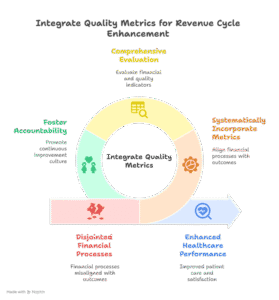The shift from fee-for-service to value-based care has introduced a significant change in the way hospitals approach patient care, quality measurement, and revenue generation. In a fee-for-service model, hospitals are reimbursed for the volume of services provided. However, in a value-based care environment, reimbursement is linked to patient outcomes, the quality of care, and overall efficiency in the healthcare delivery system. Tracking quality metrics in the hospital revenue cycle is essential to ensure compliance, optimize performance, and maximize financial health under this new model.
The Importance of Tracking Quality Metrics in the Revenue Cycle
The revenue cycle encompasses all the administrative and clinical functions related to the patient’s journey through a healthcare facility, from registration to the final payment. Under value-based care, hospitals must track a variety of quality metrics that impact not only patient care but also reimbursement. These metrics can directly affect the hospital’s bottom line by influencing reimbursement rates, penalties, and the potential for incentive bonuses.
Tracking quality metrics in the revenue cycle is critical for several reasons:
-
Compliance and Risk Mitigation: Hospitals must meet the quality benchmarks set by Medicare, Medicaid, and private insurers under value-based care contracts. Failure to meet these benchmarks can result in penalties and reduced reimbursements.
-
Optimizing Financial Performance: By focusing on quality improvement, hospitals can increase the chances of achieving higher reimbursement rates tied to positive patient outcomes.
-
Improved Patient Care: As hospitals focus on quality metrics, the overall patient care experience improves, resulting in fewer readmissions, better patient satisfaction, and more favorable clinical outcomes.
Key Quality Metrics in Value-Based Care
Several key metrics must be tracked throughout the hospital revenue cycle to ensure that value-based care objectives are met. These metrics are often linked to specific payment models, such as bundled payments, Accountable Care Organizations (ACOs), or the Merit-Based Incentive Payment System (MIPS). Some of the most important metrics include:
-
Patient Satisfaction: Measures such as the Hospital Consumer Assessment of Healthcare Providers and Systems (HCAHPS) survey are used to evaluate patient satisfaction. Patient experience is a significant quality metric that affects hospital reimbursement under value-based care. Hospitals that achieve high patient satisfaction ratings are rewarded with higher reimbursements.
-
Readmission Rates: A critical metric for assessing the quality of care, readmission rates measure how often patients return to the hospital within a short period (e.g., 30 days) after being discharged. Reducing readmissions not only improves patient outcomes but also ensures hospitals avoid financial penalties under the Hospital Readmission Reduction Program (HRRP).
-
Care Coordination: Effective coordination between different healthcare providers is vital for ensuring that patients receive the right care at the right time. Quality metrics in care coordination include tracking the timeliness of referrals, discharge planning, and follow-up care. Hospitals that excel in care coordination are often eligible for shared savings in value-based care models.
-
Clinical Outcomes: The primary focus of value-based care is improving patient outcomes, such as reducing mortality rates, improving control over chronic conditions (e.g., diabetes or hypertension), and minimizing complications from surgeries. These metrics are often tracked through registries and electronic health records (EHR) to assess the effectiveness of treatments and interventions.
-
Preventive Care Measures: Quality metrics related to preventive care include immunization rates, cancer screenings, and chronic disease management. Hospitals must track how effectively they deliver preventive care to reduce the need for more costly and intensive interventions in the future.
-
Cost Efficiency: In value-based care models, hospitals are incentivized to provide care at the lowest possible cost without compromising quality. Metrics such as average length of stay (ALOS), resource utilization, and cost per episode of care are critical for assessing cost efficiency and ensuring that hospitals are managing resources effectively.
-
Patient Safety: Patient safety indicators, such as the incidence of hospital-acquired infections (HAIs), medication errors, and falls, are crucial in value-based care models. Hospitals that focus on improving safety reduce the likelihood of penalties related to poor patient outcomes.
Integrating Quality Metrics into the Revenue Cycle

To effectively track quality metrics, hospitals need to integrate these measures into their existing revenue cycle workflows. This requires collaboration across departments, including billing, coding, clinical staff, and finance teams. Here’s how quality metrics can be integrated into the revenue cycle:
-
Data Collection: Hospitals need robust data collection systems, such as EHRs, clinical registries, and patient management systems, to track quality metrics in real-time. These systems should be capable of capturing clinical data, patient feedback, and administrative data to generate accurate and timely reports.
-
Performance Monitoring: Once the data is collected, hospitals must establish mechanisms to monitor performance on key quality metrics. This could involve creating dashboards or scorecards that allow administrators to track performance over time and identify areas needing improvement.
-
Coding and Documentation: Accurate coding and documentation are essential for ensuring that quality metrics are properly reported. Proper documentation not only ensures that hospitals receive the appropriate reimbursements but also supports the tracking of patient outcomes and other quality measures.
-
Clinical Review and Feedback: Regular clinical reviews should be conducted to assess whether hospitals are meeting quality benchmarks. Feedback loops must be established to ensure that clinicians and staff are aware of their performance on quality metrics, allowing for improvements where necessary.
-
Collaboration Across Departments: The integration of quality metrics into the revenue cycle requires strong collaboration between the clinical, administrative, and financial teams. For example, billing staff need to be aware of quality metrics that may affect reimbursement rates, while clinical teams must ensure that the care delivered aligns with quality measures.
-
Continuous Improvement: Hospitals should foster a culture of continuous quality improvement. This involves regularly reviewing performance data, making necessary adjustments to processes, and providing ongoing education to staff about quality improvement goals.
Overcoming Challenges in Tracking Quality Metrics
Tracking quality metrics in the hospital revenue cycle can be challenging, especially for large healthcare systems. Some of the key challenges include:
-
Data Integration: Data from various sources (e.g., EHRs, claims data, patient surveys) must be integrated and analyzed in a meaningful way. Data silos can hinder the ability to monitor quality metrics across the hospital efficiently.
-
Complexity of Metrics: There are numerous quality metrics, each with different reporting requirements. Hospitals must prioritize which metrics are most important and ensure they are tracked and reported accurately.
-
Resource Constraints: Implementing a robust quality metric tracking system requires time, personnel, and financial resources. Hospitals may face challenges in allocating these resources while maintaining daily operations.
-
Resistance to Change: Staff may resist changes in workflows, especially if they feel the new metrics tracking system is burdensome or disruptive. Effective communication and staff buy-in are critical to the success of these initiatives.
The Role of Technology in Tracking Quality Metrics
Advanced technology solutions can significantly streamline the tracking of quality metrics. These include:
-
Electronic Health Records (EHRs): EHRs capture real-time data on patient care and outcomes, allowing hospitals to track a wide range of quality metrics efficiently.
-
Data Analytics Tools: These tools can aggregate data from multiple sources, providing insights into quality performance and identifying areas for improvement.
-
Revenue Cycle Management (RCM) Software: RCM solutions can integrate quality metrics into the billing and coding process, ensuring accurate documentation and reporting for reimbursement purposes.
-
Clinical Decision Support Systems (CDSS): CDSS can help providers make evidence-based decisions that align with quality care goals, directly impacting clinical outcomes.
What Did We Learn?
Tracking quality metrics within the hospital revenue cycle under value-based care is essential for improving patient outcomes, achieving financial sustainability, and ensuring compliance with reimbursement requirements. By focusing on metrics like patient satisfaction, readmission rates, care coordination, clinical outcomes, and cost efficiency, hospitals can align their clinical practices with value-based care goals. Integrating these metrics into the revenue cycle through technology, data collection, and collaboration will allow hospitals to thrive in this new healthcare environment and achieve both improved patient care and financial success.
What People Are Asking?
What are quality metrics in value-based care?
Quality metrics in value-based care are measures used to assess the quality of patient care, including patient satisfaction, readmission rates, clinical outcomes, and preventive care.
How do quality metrics impact hospital reimbursement?
Hospitals are rewarded or penalized based on their performance on quality metrics, influencing reimbursement rates under value-based care contracts.
What tools are used to track quality metrics?
Tools like Electronic Health Records (EHRs), data analytics software, and Revenue Cycle Management (RCM) systems are commonly used to track and report quality metrics.
How do readmission rates affect the revenue cycle?
High readmission rates can lead to penalties under programs like the Hospital Readmission Reduction Program (HRRP), negatively impacting hospital reimbursement.
Why is patient satisfaction important in value-based care?
Patient satisfaction directly impacts reimbursement rates through metrics like the HCAHPS survey, which evaluates the quality of patient experience in the hospital.
Disclaimer
For informational purposes only; not applicable to specific situations.
For tailored support and professional services,
Please contact Staffingly, Inc. at (800) 489-5877
Email : support@staffingly.com.
About This Blog : This Blog is brought to you by Staffingly, Inc., a trusted name in healthcare outsourcing. The team of skilled healthcare specialists and content creators is dedicated to improving the quality and efficiency of healthcare services. The team passionate about sharing knowledge through insightful articles, blogs, and other educational resources.
 Book a Demo to Build Your Team Today!
Book a Demo to Build Your Team Today!


 Read Case Studies
Read Case Studies 



 Virtual Medical Assistants
Virtual Medical Assistants



